Fire safety is a crucial responsibility for any property owner, whether managing a commercial building or protecting a family home. The consequences of inadequate fire prevention measures can be devastating, both in terms of human life and financial loss. Effective use of fire detection systems and thorough risk assessments are central to ensuring safety and meeting legal obligations.
This article will explore the fundamental aspects of fire alarms and risk assessments, outlining why they are essential, how they work together, and practical steps you can take to enhance safety. We will also discuss common mistakes, industry trends, and actionable tips for both homeowners and business owners. By the end, you will have a clear understanding of how to integrate fire safety into your property management strategy.
Fire alarms and risk assessments are not just legal requirements; they are life-saving tools that give people the best chance of escaping harm.
Understanding Fire Alarms
Fire alarms are early warning systems designed to detect smoke, heat, or flames and alert occupants to evacuate. They can be manual or automatic, with detection mechanisms ranging from ionization smoke detectors to advanced addressable systems in large commercial properties.
In the UK, legislation such as the Regulatory Reform (Fire Safety) Order 2005 mandates appropriate fire detection systems in workplaces and public buildings. Similarly, many countries have specific codes requiring residential properties to have functional alarms installed in key locations.
Fire Alarm Type | Best Use Case | |
|---|---|---|
| Ionization Smoke Detector | General home use | |
| Photoelectric Smoke Detector | Smoldering fires detection | |
| Heat Detector | Kitchens or garages | |
| Addressable Fire Alarm System | Large commercial buildings |
As shown in the table above, the choice of alarm system depends on the property’s size, layout, and specific risks.
See our wide range of Fire Alarms
The Role of Risk Assessments
A fire risk assessment is a systematic evaluation of a property to identify fire hazards, assess risks, and determine the measures needed to reduce them. For commercial property safety, this is not just best practice—it is a legal obligation in many jurisdictions.
The assessment process typically involves:
- Identifying potential ignition sources
- Recognizing combustible materials
- Evaluating who might be at risk
- Assessing existing fire safety measures
- Planning necessary improvements
A thorough risk assessment ensures that fire alarms are part of a wider, integrated safety system. For example, identifying a high-risk storage area for flammable liquids may lead to installing a heat detector rather than a smoke detector.
See more about Fire Risk Assessments
A risk assessment without proper follow-through is like a fire alarm without batteries—it looks reassuring but won’t save lives.
Integrating Fire Alarms with Risk Assessments
Fire alarms and risk assessments complement each other. The assessment identifies what type of alarm system is needed and where it should be placed, while alarms provide the practical warning mechanism during an incident.
For instance, in a commercial kitchen, a risk assessment might identify high heat and smoke from cooking as factors that could trigger false alarms. The solution may involve installing heat detectors instead of smoke detectors, ensuring reliable alerts without unnecessary disruptions.
Integration also extends to maintenance. Regular reviews of both the alarm systems and the risk assessment ensure that safety measures keep pace with changes in property layout, occupancy, or use.
Common Mistakes to Avoid
Even when property owners invest in fire safety systems, mistakes in implementation or maintenance can undermine their effectiveness:
- Neglecting maintenance: Batteries die, sensors degrade, and systems become outdated.
- Poor placement: Installing alarms too close to kitchens without considering false alarms.
- Ignoring legal obligations: Failing to carry out mandated risk assessments or keep records.
- Not training occupants: Alarms are only effective if people know how to respond.
Avoiding these mistakes requires ongoing vigilance and a commitment to regular checks and updates.
Industry Trends and Future Outlook
Advancements in technology are transforming fire safety. Modern systems include wireless connectivity, integration with smart home or building management systems, and real-time alerts to mobile devices.
Emerging trends include:
- AI-powered fire detection that reduces false alarms
- Integration with IoT devices for automated emergency responses
- Cloud-based monitoring for large commercial facilities
These innovations improve response times and make systems more reliable and easier to maintain.
Implementation Guide for Property Owners
For those looking to enhance fire safety:
- Conduct or update a fire risk assessment: Engage a qualified professional.
- Select appropriate fire alarms: Based on risk assessment findings.
- Install alarms correctly: Follow manufacturer and legal guidelines.
- Train occupants: Conduct regular fire drills.
- Maintain and review: Schedule regular system tests and reassess risks annually.
Step | Action | Frequency |
|---|---|---|
| Risk Assessment | Hire certified assessor | Annually |
| Alarm Testing | Check all units | Monthly |
| Drills | Conduct evacuation drills | Twice a year |
| System Upgrade | Review tech and compliance | Every 5 years |
By following this structured approach, property owners can significantly reduce fire-related risks.
Conclusion
Fire alarms and risk assessments are essential components of a comprehensive fire safety strategy. For homeowners, they offer peace of mind that loved ones are protected. For business owners and property managers, they help meet legal obligations and safeguard assets.
The key is to view fire safety not as a one-time task but as an ongoing commitment. By integrating advanced alarm systems with thorough and regularly updated risk assessments, property owners can create an environment where safety is embedded into daily operations.
Investing in fire safety is not just about compliance—it’s about protecting lives, preserving property, and ensuring that when the unexpected happens, you are ready to respond effectively.
Contact us and speak to our friendly and knowledgeable fire safety experts.

